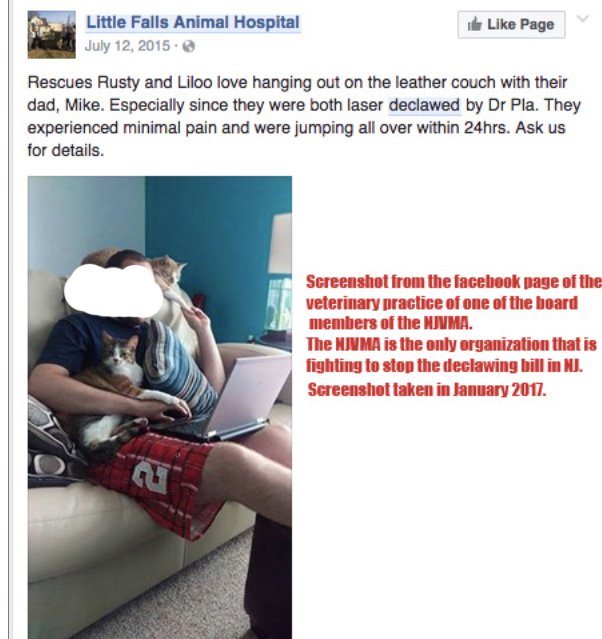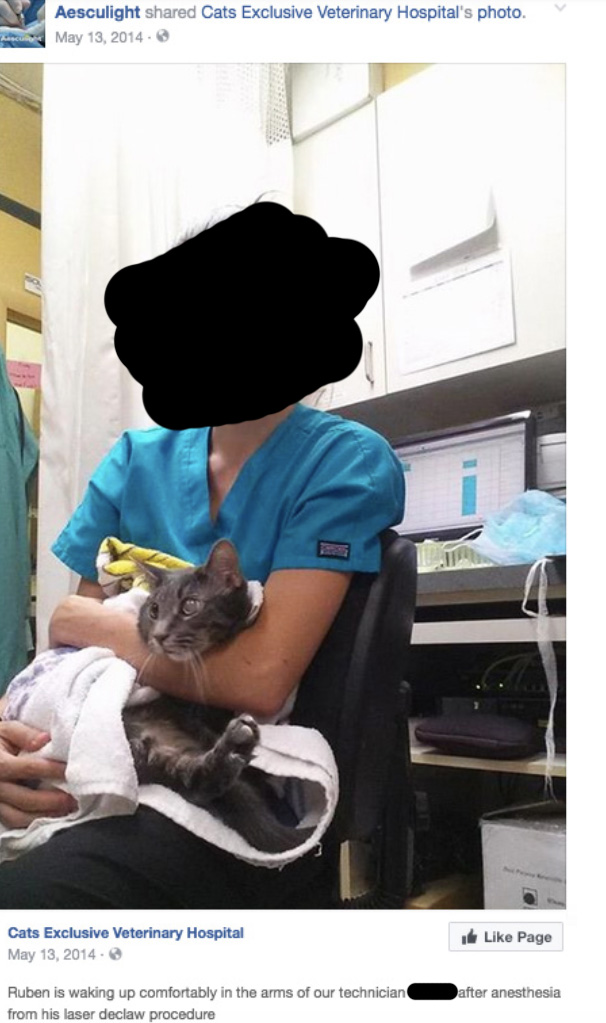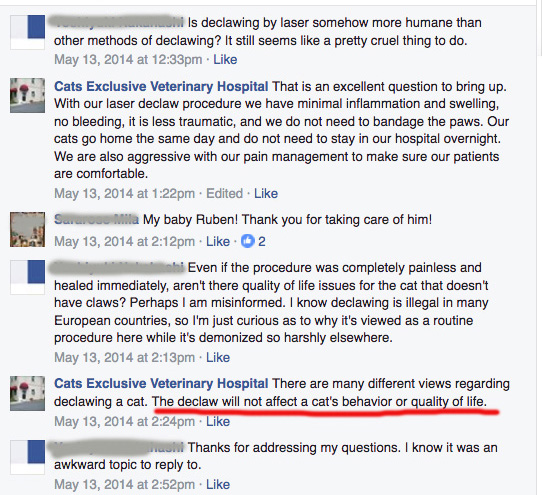 This is a cat’s toe bone and claw that was amputated with a laser. The photo is not from the veterinary practices mentioned in this story.
This is a cat’s toe bone and claw that was amputated with a laser. The photo is not from the veterinary practices mentioned in this story.
This story is to educate people about the truth about declawing. If you want to share this story with these New Jersey veterinarians, please do it in a respectful way so that they will be educated on the FACTS about declawing.
Dr Jose Pla, New Jersey veterinarian, was recently quoted in a story by NHPR about the declawing bill in New Jersey. He says in the story, “”It is amputation,” Pla says. “But these cats with modern surgical techniques are going home the same day. No bandages. Walking.”
Here is the story. http://nhpr.org/post/declaw-law-veterinarians-divided-over-nj-cat-claw-bill
Dr Jose Pla’s business partner, Dr Neal Beeber, is a board member with the New Jersey Veterinary Medical Association. The NJVMA is the only organization that is actively trying to stop the declawing bill in New Jersey.
Dr Jose Pla works at Cats Exclusive Veterinary Hospital and Dr Neal Beeber works at Little Falls Animal Hospital, both in New Jersey. Cats Exclusive Veterinary Hospital is an AAHA hospital. Did you see how AAHA made a Declaw Communications Toolkit for their vets who declaw cats. Here it is- [button href=”https://citythekitty.org/aahas-declaw-communications-toolkit/” color=”red” newwindow=”yes”] AAHA Declaw Communications Toolkit[/button]
Dr Jose Pla is the vet who does their declaws. They advertise their laser declaws on their facebook pages, their employees say that Dr Pla performs declaws, “all the time”, ” Dr Beeber says that a cat will be ok from being declawed, they post photos of declawed cats and promote their laser declaw, and they charge $875 for their laser declaws and will even do them on older cats. They also provide you with Purina’s Yesterday’s News Cat litter. Purina makes millions of dollars a year from declawing with the sale of their Yesterdays News Cat Litter. (UPDATE- Purina stopped making Yesterday’s News litter in 2022 because of dwindling sales.)
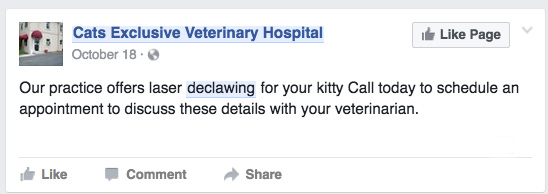
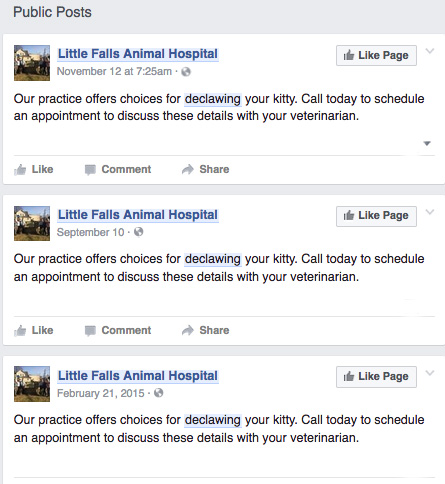 A cat owner asked Dr Beeber about these facebook posts on his and Dr Pla’s veterinary practice’s facebook page that say, “Our practice offers choices for declawing your kitty. Call today to schedule an appointment to discuss these details with your veterinarians.”
A cat owner asked Dr Beeber about these facebook posts on his and Dr Pla’s veterinary practice’s facebook page that say, “Our practice offers choices for declawing your kitty. Call today to schedule an appointment to discuss these details with your veterinarians.”
Dr Beeber explained, “We try to talk people out of doing it the other way, it’s not as good.”
Beeber said, “I don’t do them but my partner (Dr Pla) does it at our cats only hospital.” Beeber said that his partner, Dr Pla, was one of the first veterinarians in NJ to do them so he has a lot of experience. Beeber said, “He’s probably more experienced than anyone in the state. He’s really good at them.”
Dr Beeber put the receptionist on the line. She asked, “Do your cats have a problem since we don’t like to automatically declaw.” Cat owner said, “Yes they like to scratch the sofa.” Receptionist said, “ok” and gave the prices. Declaw/neuter $985, declaw for the 3 yr old cat is $875.
Cat owner was concerned if their cats would be ok after the declaws and asked if Dr Jose Pla is skilled at them? She said, “He does them all the time at our other office (Cats Exclusive Animal Hospital) and he used to do them quite often when he worked in this office. He knows exactly what he’s doing .”
Here is a post by their vet practice and comments that was shared by the biggest laser company that markets their lasers to veterinarians for declawing. The laser machines cost around $40,000 and these vets have to do a lot of declaws to pay back the bill.
Here is the review by this doctor, Dr Jose Pla of Cats Exclusive Veterinary Hospital in Ridgefield, New Jersey on his own facebook page. Dr Pla’s partner vet is Dr Neal Beeber, board member of the NJVMA. Dr Pla gave his practice a 4 out of 5 star review.[button href=”https://www.facebook.com/Cats-Exclusive-Veterinary-Hospital-160957067259466/reviews?__xt__=33.%7B%22logging_data%22%3A%7B%22page_id%22%3A160957067259466%2C%22event_type%22%3A%22clicked_all_page_reviews%22%2C%22impression_info%22%3A%22eyJmIjp7InBhZ2VfaWQiOiIxNjA5NTcwNjcyNTk0NjYiLCJpdGVtX2NvdW50IjoiMCJ9fQ%22%2C%22surface%22%3A%22www_pages_home%22%2C%22interacted_story_type%22%3A%221076727669006899%22%2C%22session_id%22%3A%2204e6e5abd4d3b78c2745cdd6119d1016%22%7D%7D” color=”red” newwindow=”yes”] Review by Dr Jose Pla of his own Cats Exclusive Veterinary Hospital[/button]
“Prior to performing a declaw we require owners to schedule a consult to determine the eligilibility of the pet for the procedure. We adhere to the position statements of both the AAFP and the AVMA that clearly stipulate that declawing is only to be done as a last resort. We never declaw “preventively” or simply based on owners request.
The net result of these consults is that we decline 30-40% of requested surgeries. We then work closely with owners to help institute appropriate play and home care techniques that are aimed to help raise well adjusted cats
Finally, given modern surgical procedures such as laser surgery along with appropriate use of anti-inflammatories and analgesics, our clients routinely report that their pets are walking and playing the same day of surgery. To this date we have never had an owner report any adverse behavior changes or any type of lameness in our surgical patients. Our biggest problem is convincing owners to continue with medications even though the owners report that their pets are fully healed
We are in full agreement that cats can suffer from needless surgery or from poor pain management and antiquated surgical techniques. However simply banning a procedure that prevents an owner from either relinquishing their pet to a shelter or abandoning outdoors is in my opinion a worse option
As a society we all need to understand that there are no perfect answers to many of the problems that pet owners face. The veterinary oath is clear “First do no harm”. While many interpret this as stating that declawing should always be banned, we must also answer the “harm” to the cat from not performing a surgery that ensures that it remains in their “forever home”. Until we answer the latter, we should refrain from disparaging both owners and veterinarians that are looking to ensure these few cats have a loving “animal-human bond”
Dr. Jose Pla “
Reply from Cats Exclusive Veterinary Hospital While I respect your right to have an opinion. It is important that you provide accurate information. Declawing does not affect the toe pads or result in cats “walking on bones”. Removal of P3 does not change how cats bare weight as the toe pad is at the end of P2 and is not affected by the surgery. Additionally, at no time are any bones “burned”. The surgery is a disarticulation of the joint. We only cut through soft tissues (ligaments, tendons and skin). I fully agree that “Soft Paws” and nail trimming are viable options for most cats. Declawing is reserved for those few cats that do not permit us or their owners to safely trim nails AND are either destructive or injuring their owners.
FACTS-
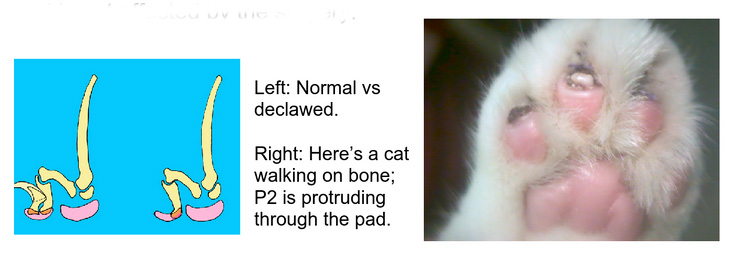 The change in focus of weight from the base of the amputated P3 to the much smaller surface of the distal P2 is so significant that it actually alters the shape of the paw pads.
The change in focus of weight from the base of the amputated P3 to the much smaller surface of the distal P2 is so significant that it actually alters the shape of the paw pads.

ALTERNATIVE FACT- “Additionally, at no time are any bones “burned”.”
FACTS- Not on purpose, of course. But one only has to look on VIN to find numerous cases where the distal end of P2 has been accidentally charred.
There are a lot of lousy surgeons out there. How do they propose stopping them? There are no laws or regulations requiring vets to use a laser, or to use adequate pain medication, to prevent errors, let alone be good at the surgery. And even “good” surgeons who use “good” pain management still inflict the identical long-term consequences. Sorry, a legal ban is the only way.
ALTERNATIVE FACTS- “The surgery is a disarticulation of the joint. We only cut through soft tissues (ligaments, tendons and skin). I fully agree that “Soft Paws” and nail trimming are viable options for most cats. Declawing is reserved for those few cats that do not permit us or their owners to safely trim nails AND are either destructive or injuring their owners.”
FACTS- Rescos, guillotine style, (still used by ~30% of vets) do cut directly through bone. And those “soft tissues” include nerves—cutting nerves is extremely painful.
Again with the “few cats” – 60-70% is not a “few cats.” And is a lifetime of pain for the cat worth more a nice sofa? We don’t think so.
ALTERNATIVE FACTS– Comments from Dr Pla’s partner vet, Dr Neal Beeber, who is a board member of the NJVMA and told a cat owner on the phone, “we do it with a laser. It takes away the pain and discomfort…” [button href=”https://citythekitty.org/studynjvetsdeclawing/” newwindow=”yes”] City the Kitty Declawing Study #7 & #8 Dr Beeber & Dr Pla’s veterinary practices [/button]
FACT- Laser declawing is no less painful than any other technique after the 24 hours. There is less bleeding and swelling in the immediate post-op period, but that’s the limit of its “advantages.”
ALTERNATIVE FACTS– Comments from Dr Pla, “Prior to performing a declaw we require owners to schedule a consult to determine the eligilibility of the pet for the procedure. We adhere to the position statements of both the AAFP and the AVMA that clearly stipulate that declawing is only to be done as a last resort. We never declaw “preventively” or simply based on owners request.”
FACTS- The City the Kitty declawing survey results prove otherwise. [button href=”https://citythekitty.org/studynjvetsdeclawing/” newwindow=”yes”] Number #7 and #8 in my declawing study[/button]
ALTERNATIVE FACTS– Comments from Dr Pla, “The net result of these consults is that we decline 30-40% of requested surgeries. We then work closely with owners to help institute appropriate play and home care techniques that are aimed to help raise well adjusted cats.”
FACTS- So 60-70% still “need” to be declawed? Do they require (as AVMA policy stipulates) that owners try “appropriate play” and all the other dozen alternatives BEFORE declawing them? Or is the threshold for declawing what it sounds like in the survey, just a statement by the owner that the cat “has a problem” with scratching?
ALTERNATIVE FACTS- Comments from Dr Pla, “Finally, given modern surgical procedures such as laser surgery along with appropriate use of anti-inflammatories and analgesics, our clients routinely report that their pets are walking and playing the same day of surgery. To this date we have never had an owner report any adverse behavior changes or any type of lameness in our surgical patients. Our biggest problem is convincing owners to continue with medications even though the owners report that their pets are fully healed.”
FACTS- The issue is that complications can occur months or even years later: claw regrowth, arthritis, abscesses, etc. Vets just don’t believe that this happens, and even when it does, unless it’s obvious like an abscess, they do not attribute it to declawing.
Comments from Dr Pla, “We are in full agreement that cats can suffer from needless surgery or from poor pain management and antiquated surgical techniques.” “However simply banning a procedure that prevents an owner from either relinquishing their pet to a shelter or abandoning outdoors is in my opinion a worse option.”
So how do they propose stopping those vets from declawing? There is no mechanism for enforcing techniques and protocols. Our opinion differs, and we have studies that back ours up.
ALTERNATIVE FACTS- Comments from Dr Pla, “As a society we all need to understand that there are no perfect answers to many of the problems that pet owners face. The veterinary oath is clear “First do no harm”. While many interpret this as stating that declawing should always be banned, we must also answer the “harm” to the cat from not performing a surgery that ensures that it remains in their “forever home”. Until we answer the latter, we should refrain from disparaging both owners and veterinarians that are looking to ensure these few cats have a loving “animal-human bond”
FACTS- The veterinarian’s oath says no such thing (neither does the physician’s oath). Not even close.
“These few cats” – you mean, that 60-70% of cats that you WILL declaw on request as long as the owners say that scratching is a problem?
There is no evidence that declawing keeps cats in “forever homes.” In fact, homes where declawing is required are at high risk for becoming quite temporary. Behavior experts believe that the same people who are intolerant of their cats’ scratching behavior (to the extent of having the cat declawed) will also be intolerant of any other unwanted behavior—and if another behavior issue develops, will quickly get rid of the cat, presumably by any means: relinquishment, abandonment, or euthanasia. [Overall 2003, Patronek 2001]
Here is a facebook page that shows you some of the thousands of declawed cats who are being thrown away, every single day, by their owners in America.This is just on facebook. For the last 6 months there have been 2,025 unwanted declawed cats that people gave up for no reason or excuses like they were moving or they all of a sudden developed allergies to the cat. 1,121 were thrown away to a shelter. 1,511 were found outside. 176 with complications such as litter box avoidance, bting, claw growth, etc. [button href=”https://www.facebook.com/BetrayedDeclawedCats/” color=”red” newwindow=”yes”] Betrayed Declawed Cats[/button]
“For example, if owners with a low tolerance for behavior problems are more likely to declaw their cats to begin with, and also more likely to relinquish their cats if they do begin to exhibit inappropriate elimination, then this could explain the apparent higher incidence of inappropriate elimination in declawed relinquished cats. [Patronek 2001]
Given that up to 1/3 of declawed cats do develop a secondary behavior problem, and given that declawed cats are nearly twice as likely to be relinquished as clawed cats [Patronek 1996], those “forever homes” are looking extremely tenuous at best.

